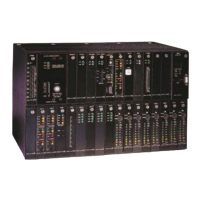Chapter 4. Configuration and Operation
103
Setup and Programming Order
This section lists the programming commands in the order recommended for configuration and operation
of the network and local systems. The two letter commands, and appropriate reference figure numbers,
are included.
If this is the first time the shelf is to be programmed, or if it needs to be reset to factory defaults, do an
NVRAM clear.
To do an NVRAM clear, perform the following steps:
1. Power down the shelf.
2. Press both the Alarm Cut-Off (ACO) and Bypass (BYP) buttons (located on the CCU/MCU front
panel).
3. Power-up the shelf while continuing to press the ACO and BYP buttons.
4. After 60 seconds, release the two buttons.
The shelf is now set to 1200 bps data rate and all the settings are factory default settings.
The logical programming order for the CCU is as follows.
1. Access CCU - D/I Mux III user submenu (AC) - Figure 4-6
2. Set communication Rate (SR) - Figure 4-61
3. Set shelf Configuration (SC) - Figure 4-44
4. Set system Parameters (SP) - Figure 4-60
5. Set Line card configuration (SL) - Figure 4-53
6. Set/edit a Map matrix (SM) - Figure 4-54
7. Set/edit a map Table (ST) - Figure 4-64
8. Set the New working map (SN) - Figure 4-58
9. Set clock Source (SS) - Figure 4-62
10. Select (Performance) operation options - if using a Facility Data Link Processor (FDLP) (PM) -
Figure 4-37
11. Set the passWords (SW) - Figure 4-65
12. Set alarm report Options (SO) - Figure 4-59
For the MCU, the logical programming order for both the local and network parameters is as follows:
1. View Network parameters (VN) - Figure 4-67
2. Modify/set IP Address (MI) - Figure 4-27
3. Modify/set Subnet Mask (MS) - Figure 4-31
4. Modify/set Gateway IP Address (MG) - Figure 4-26
5. Modify/set SLIP parameters (ML) - Figure 4-28
6. Modify/set keyboard Time-out (MT) - Figure 4-32
7. View Manager configuration (VM) - Figure 4-66
8. Remove (erase) default Manager (if necessary) (RM) - Figure 4-39

